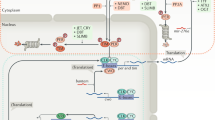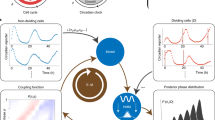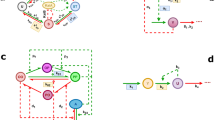Abstract
A CIRCADIAN clock, which continues to oscillate in constant conditions, is almost ubiquitous in eukaryotes as well as some prokaryotes1. This class of biological oscillators drives daily rhythms as diverse as photosynthesis in plants2 and the sleep-wake cycle in man3 and enables organisms to anticipate environmental changes or segregate in time-incompatible processes4. Circadian oscillators share many properties, suggesting that the clock is a single mechanism, preserved throughout evolution, which is capable of controlling all the different circadian functions. Here we show that two rhythms in a unicellular organism can, under certain experimental conditions, run independently, and thus each rhythm must be controlled by its own distinct oscillator.
This is a preview of subscription content, access via your institution
Access options
Subscribe to this journal
Receive 51 print issues and online access
$199.00 per year
only $3.90 per issue
Buy this article
- Purchase on Springer Link
- Instant access to full article PDF
Prices may be subject to local taxes which are calculated during checkout
Similar content being viewed by others
References
Hastings, J. W., Rusak, B. & Boulos, Z. in Neural and Integrative Animal Physiology (ed. Prosser, C. L.) 435–546 (Wiley-Liss, Cambridge, 1991).
Hastings, J. W., Astrachan, L. & Sweeney, B. M. J. gen. Physiol. 45, 69–76 (1961).
Wever, R. The Circadian System of Man (Springer, Berlin, 1979).
Huang, T.-C., Tu, J., Chow, T.-L. & Chen, T.-H. Pl. Physiol. 92, 531–533 (1990).
Hastings, J. W. & Sweeney, B. M. Biol. Bull. 115, 440–458 (1958).
Roenneberg, T., Colfax, G. N. & Hastings, J. W. J. biol. Rhythms 4, 201–216 (1989).
Roenneberg, T. & Hastings, J. W. in Oscillations and Morphogenesis (ed. Rensing, L.) 399–412 (Dekker, New York, 1992).
Morse, D., Fritz, L. & Hastings, J. W. Trends biochem. Sci. 15, 262–265 (1990).
Halberg, F., Cornelissen, G. & Broda, H. Cell Biophysics 8, 69–85 (1985).
Hoist, E.v. Ergebn. Physiol. 42, 228–306 (1939).
Aschoff, J. in Biological Rhythms (ed. Aschoff, J.) 81–93 (Plenum, New York. 1981).
Krasnow, R. et al. J. comp. Physiol. 138, 19–26 (1980).
von der Heyde, F., Wilkens, A. & Rensing, L. J. biol. Rhythms 7, 115–124 (1992).
McMurry, L. & Hastings, J. W. Science 175, 1137–1139 (1972).
Broda, H., Gooch, V. D., Taylor, W. R., Aiuto, N. & Hastings, J. W. J. biol. Rhythms 1, 251–263 (1986).
Aschoff, J. Science 148, 1427–1432 (1965).
Aschoff, J., Gerecke, U. & Wever, R. Jap. J. Physiol. 17, 450–457 (1967).
Daan, S., Beersma, D. G. M. & Borbely, A. A. Am. J. Physiol. 246, R161–R178 (1984).
Hastings, J. W. & Sweeney, B. M. Proc. natn. Acad. Sci. U.S.A. 43, 804–811 (1957).
Edmunds, L. N. Jr Cellular and Molecular Bases of Biological Clocks: Models and Mechanisms of Circadian Time Keeping (Springer, New York, 1988).
Schweiger, E., Wallraff, H. G. & Schweiger, H. G. Science 146, 658–659 (1964).
Schweiger, E., Wallraff, H. G. & Schweiger, H. G. Z Naturforsch. 19c, 499–505 (1964).
Schwartz, R. M. & Dayhoff, M. D. Science 199, 395–403 (1978).
Margulis, L. Symbiosis in Cell Evolution (Freeman, New York, 1091).
Taylor, W., Wilson, S., Presswood, R. P. & Hastings, J. W. J. Interdiscipl. Cycle Res. 13, 71–79 (1982).
Box, G. E. P. & Jenkins, G. M. Time Series Analysis—Forecasting and Control (Holden-Day, San Francisco, 1970).
Author information
Authors and Affiliations
Rights and permissions
About this article
Cite this article
Roenneberg, T., Morse, D. Two circadian oscillators in one cell. Nature 362, 362–364 (1993). https://doi.org/10.1038/362362a0
Received:
Accepted:
Published:
Issue Date:
DOI: https://doi.org/10.1038/362362a0
This article is cited by
-
Effects of circadian clock and light on melatonin concentration in Hypericum perforatum L. (St. John’s Wort)
Botanical Studies (2020)
-
Diel transcriptional response of a California Current plankton microbiome to light, low iron, and enduring viral infection
The ISME Journal (2019)
-
Holobiont chronobiology: mycorrhiza may be a key to linking aboveground and underground rhythms
Mycorrhiza (2019)
-
Lunar gravity affects leaf movement of Arabidopsis thaliana in the International Space Station
Planta (2015)
-
The Lingulodinium circadian system lacks rhythmic changes in transcript abundance
BMC Biology (2014)
Comments
By submitting a comment you agree to abide by our Terms and Community Guidelines. If you find something abusive or that does not comply with our terms or guidelines please flag it as inappropriate.



